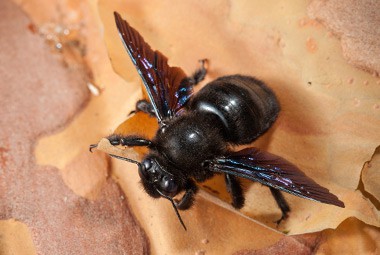
Carpenter bees are a solitary species of bee that get their name because they build tunnels and nesting areas inside of wood. One of the most common species that creates the most damage for property owners and that is found throughout most of the United States is Xylocopa Virginica (L). This species of carpenter bee can be found from Kansas south to Texas and eastward to the Atlantic.
| Pest Identification | |
|---|---|
| Recognition | Carpenter bees are very often confused with bumblebees because of their similar appearance. They are both black and yellow in color and have a fuzzy appearance, however carpenter bees often lack stripes and have a smooth hairless abdomen. Carpenter bees have an oval full-bodied shape and are a large species of bee. Adults can grow to be ¼ to 1 inch in length depending on their species. |
| Biology | After overwintering inside of old nesting tunnels adult carpenter bees will emerge in the spring to mate and create new nesting areas (galleries) to lay eggs in. The female may decide to use and remodel an existing gallery or create an entirely new nesting area. To create a new gallery she will make a hole about the diameter of her body 3/8- ½ of an inch inside of a suitable piece of wood. Then she tunnels further into the wood and will make a right-angle turn with the grain of the wood. The longer a particular gallery is in use the larger it will be. Some can grow to be over 10 feet in length. After she creates her nesting area the female will start at the far end of the nest and place an egg on top of a pile of gathered pollen and nectar. Then sealing off the area around the egg with a saliva wood pulp mixture she is effectively making an incubation chamber. She repeats this process day after day until all of her eggs are deposited. Depending on the species this can be 5-8 eggs and they can take 36-99 days to develop. While each female independently lays and take care of her eggs, several females may choose the same area or piece of wood to create their nests in. |
| Habits | Carpenter bees prefer to create their nesting areas in softwood that has not been painted, stained or treated in any way, but if need be, they may attack painted or stained wood as well. Common places that carpenter bees can be found building their nesting in are decks, porches, roof eaves, wood play structures, sheds, and wooden lawn furniture. It is important to note that carpenter bees do not eat the wood they are invading, they just tunnel through the wood removing the debris which then builds up in a pile outside of the entry hole. Carpenter bees tend to either use the same galleries year after year or create new galleries in the same area year after year. This can lead to increased damage and can weaken the structural integrity of the place that they have invaded. Female carpenter bees do have a stinger, but are not very aggressive and will rarely sting. Their venom is however potent enough to cause an allergic reaction in some people. Male carpenter bees are very aggressive and will defend their nesting sites by buzzing around and flying aggressively at the person or animals that they perceive as a threat. However, their “bark” is bigger than their “bite” since the males do not have a stinger. |
| Prevention | The best defense against carpenter bees is to make sure that any wood used to create a structure on your property has been stained or painted since they prefer to invade untreated wood. Also, any holes found in wood on your property should be sealed and the wood around the holes should be sanded smooth. |
| Professional | The best way to control and eliminate a carpenter bee infestation on your property is to get professional help. A Rottler technician will come to your home and inspect your property finding and providing treatment for each individual entry hole and gallery. Our trained technicians will use an appropriately labeled residual insecticide and apply using aerosol injection systems, compressed air sprayers, or dust application equipment depending on the unique situation. |

